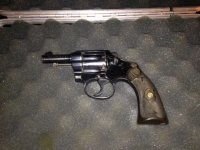Hello All,
I am a newbie to the Firing Line, and I thought it would be a great place to read and learn. I have a question about my (only) firearm that hopefully someone can help.
I have a 1912 Colt Police Positive .32, serial # 98xxx. Bought at an auction about 11 years ago for just under 100.00. I have shot it a couple of times, and like how it shoots and like the size. The only "problem" with it is that the hammer spur is missing (bought it just like you see it). Is it worth the money to try to replace (or can it be replaced feasibly)? Any and all answers welcome, good to be here.

I am a newbie to the Firing Line, and I thought it would be a great place to read and learn. I have a question about my (only) firearm that hopefully someone can help.
I have a 1912 Colt Police Positive .32, serial # 98xxx. Bought at an auction about 11 years ago for just under 100.00. I have shot it a couple of times, and like how it shoots and like the size. The only "problem" with it is that the hammer spur is missing (bought it just like you see it). Is it worth the money to try to replace (or can it be replaced feasibly)? Any and all answers welcome, good to be here.

